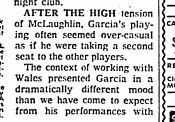These new nights are lightly regarded compared to other shows at the Palladium and from the Spring tour 1977 but still worth considering which you can do here
Set two of May 1, 1977 is just another one of those really great May 77 nights. What is so remarkable is that in a Jambase poll of the Spring tour, this show got 1% of the vote. Think of that 1% with that setlist. Listen and tell me what you think. Most underrated show of May 1977?
April 29 is a gem as are April 30 and May 4, all of which you can read about at this blog
http://gratefulseconds.blogspot.com/2017/02/opening-night-at-palladium-april-29-1977.html
http://gratefulseconds.blogspot.com/search/label/1977-04-30
http://gratefulseconds.blogspot.com/2017/02/may-4-1977-mind-melt-at-palladium.html
Sunday, May 1
Might As Well El Paso Ramble On Rose Cassidy They Love Each Other Lazy Lightnin' > Supplication Roses Estimated Prophet Tennessee Jed Sunrise Samson And Delilah
Dancing In The Street > Brown Eyed Women Playing In The Band > Drums > The Other One> Comes A Time > Playing In The Band Brokedown Palace
Tuesday May 3
The Promised Land Bertha Me And My Uncle Peggy-O Jack Straw Row Jimmy Lazy Lightnin' > Supplication Deal Good Lovin' Ship Of Fools The Music Never Stopped
Might As Well Estimated Prophet Sugaree Samson Friend Of The Devil Eyes Of The World > Space> Wharf Rat> Drums > Not Fade Away > Around And Around Uncle John's Band
Set two of May 1, 1977 is just another one of those really great May 77 nights. What is so remarkable is that in a Jambase poll of the Spring tour, this show got 1% of the vote. Think of that 1% with that setlist. Listen and tell me what you think. Most underrated show of May 1977?
April 29 is a gem as are April 30 and May 4, all of which you can read about at this blog
http://gratefulseconds.blogspot.com/2017/02/opening-night-at-palladium-april-29-1977.html
http://gratefulseconds.blogspot.com/search/label/1977-04-30
http://gratefulseconds.blogspot.com/2017/02/may-4-1977-mind-melt-at-palladium.html
Sunday, May 1
Might As Well El Paso Ramble On Rose Cassidy They Love Each Other Lazy Lightnin' > Supplication Roses Estimated Prophet Tennessee Jed Sunrise Samson And Delilah
Dancing In The Street > Brown Eyed Women Playing In The Band > Drums > The Other One> Comes A Time > Playing In The Band Brokedown Palace
Tuesday May 3
The Promised Land Bertha Me And My Uncle Peggy-O Jack Straw Row Jimmy Lazy Lightnin' > Supplication Deal Good Lovin' Ship Of Fools The Music Never Stopped
Might As Well Estimated Prophet Sugaree Samson Friend Of The Devil Eyes Of The World > Space> Wharf Rat> Drums > Not Fade Away > Around And Around Uncle John's Band
NY Times on May 1, 1977 review of April 29 show






























































